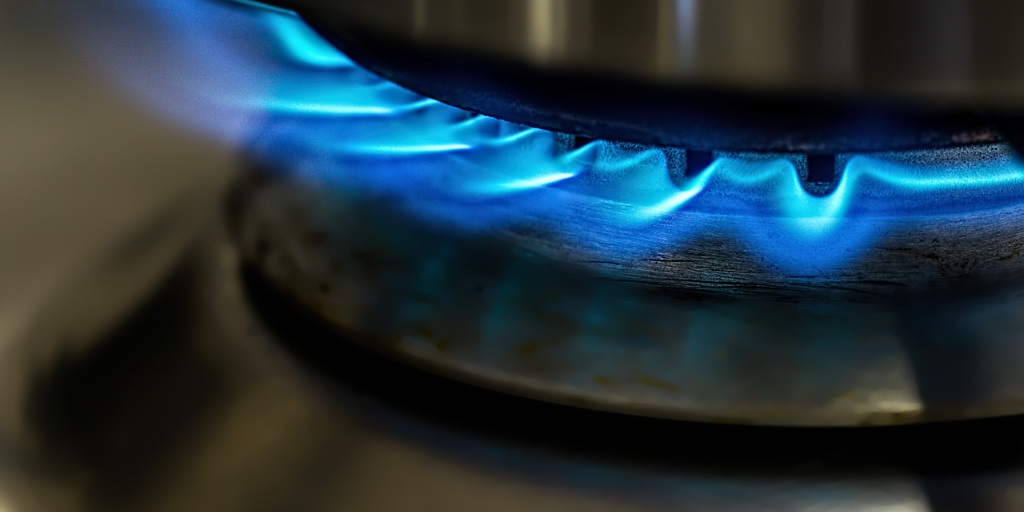What influences UK gas prices? Everything you need to know
There are many reasons why energy prices fluctuate, particularly business gas prices. This means it can sometimes be difficult to predict your energy bills and budget accordingly (even if you don't use gas at your business, electricity prices are directly linked to gas prices, but more on that later).
Run a price comparison now to find out the latest business gas prices.

Here in the UK, we have our own 'homemade' gas supply, which comes mainly from the North Sea. But this only meets around half of the UK's demand, which means our supply needs to be topped up with imports from other countries. Most gas is imported from Norway, but we also import liquefied natural gas (LNG) from the USA, Qatar, and others.
These global markets can be affected by global incidents, from natural disasters to political instability, so it's easy to see why gas prices can be so volatile.
Climate change concerns are also influencing the way we use our business energy supplies. The government is encouraging businesses to decrease fossil fuel energy use and is even penalising heavy users. Let's take a closer look at how all of these factors influence the rates you pay for gas at your business.
Five-point summary
- The UK gets gas from both home and abroad. About half comes from the North Sea, while the rest is imported from countries like Norway, the USA, and Qatar.
- Global events drive price volatility. Political unrest, natural disasters, and trade restrictions can all impact supply and push up prices.
- Wholesale gas costs are key. The biggest part of your bill comes from what suppliers pay for gas on the global market, influenced by supply, demand, and currency shifts.
- Taxes, network and environmental costs add up. Business gas prices also include costs for delivery networks, green levies like the Climate Change Levy, and taxes on production.
- Gas prices affect electricity prices too. Because so much UK electricity is still made using gas, rising gas prices usually mean higher electricity bills as well.
Where does the UK get its gas?
The UK gas supply is made up of various sources, in part because our own supply can't meet demand, but also to help ensure there’s no danger of supplies running out.
Natural gas from the North Sea and the Irish Sea makes up around 45% of what the UK needs, but the quantity is declining each year.
The UK tops up its gas supply with imports from around the world. Pipelines under the North Sea deliver Liquid Natural Gas (LNG) from Norway, Holland and Belgium to refineries along the east coast. Since 2005, the UK has shipped LNG into its storage facilities from as far afield as Asia, the Middle East, the US and Russia.
There are two main types of storage facilities - depleted gas fields and salt caverns. During periods of low demand, gas is transferred into storage and used as a backup when there is an extended period of cold weather, putting excessive demand on the gas network.
Salt caverns are being developed to store natural gas and hydrogen. Large-scale caverns are available at three UK sites - Cheshire, Dorset, and East Yorkshire - and are designed to enhance energy security and support renewable energy sources. These caverns are turned into underground storage facilities that can be filled and emptied faster than those in depleted gas fields. This means they are most frequently called on in emergencies.
How are gas prices calculated?
There are loads of moving parts when it comes to calculating the cost of gas as it makes its way from production to your premises.
Wholesale costs have the greatest influence on the price you pay, and these are also subject to many different factors. But taxes, operating costs and other things also have an impact. Let's take a closer look.
Wholesale costs
Wholesale gas prices in the UK are the amount your supplier pays to buy gas from the original producer. This price can vary due to market forces, but the gas supplier works out what they can charge customers without making a loss.
Natural gas and crude oil price charts rise and fall with changes in global demand. Any fixed-price energy deals need to be held at a price that can absorb any extreme increases in price, while still making a profit.
There are two wholesale rates to consider:
- Wholesale Forward Delivery Contracts Price - The prices agreed upon today for the future delivery of energy. If you secure a fixed rate in advance of your energy deal ending, this will be the wholesale rate your supplier uses
- Wholesale Day Ahead Contracts Price - The price at which electricity or gas is bought and sold on the spot market for delivery the following day. These will be the rates used if you're on a variable rate or your suppliers out-of-conract rates.
For more detailed information, read our guide on how energy is bought and sold in the UK.
Networks
Four main Gas Delivery Networks in the UK manage and distribute gas to homes and businesses across the UK. They’re responsible for delivering gas safely, which includes repairing leaks and replacing old pipework. The costs associated with providing this service contribute to the final price of your gas.
Environmental costs
Since 2001, businesses have paid what’s known as the Climate Change Levy (CCL). The CCL is an environmental tax charged on the energy used by businesses. It applies to those in the industrial, public services, commercial and agricultural sectors, and it’s charged on heating, lighting and power.
However, the government has introduced several measures to ensure energy-intensive industries like manufacturing are not disadvantaged when compared to foreign competitors.
Climate change is an area that is subject to new and changing initiatives. Businesses should keep up-to-date on the latest government legislation to make sure they’re not caught out.
Operating costs
Operating costs stem from the maintenance of the equipment used to produce gas. These include labour costs for all personnel who perform modifications and maintenance of machinery and other equipment.
Maintenance work is essential to avoid costly production downtime. By keeping on top of it, suppliers prevent expensive repairs and keep operating costs low over time. And while operating costs might jump if a supplier opens a new field, they’ll start to decrease again over time.
Tax
Gas producers have to pay tax on their profits, just as any other business. There are three forms of tax levy:
- Ring Fence Corporation Tax - Ring fence corporation tax gives companies 100% allowances in the first year for most of their capital expenditure. It means that no other activities that offer tax relief will reduce the profits businesses get from gas extraction.
- Supplementary Charge - The ring-fenced profits of a company are subject to an additional charge but it doesn’t reduce finance costs from them.
- Petroleum Revenue Tax - PRT tax stops any exploitation of gas and oil in the UK so a fair share of the profits is returned to the country. This tended to be more applicable in the past when it was introduced in 1974, but more recently ‘super-profits’ are less likely, and the UK Government has reduced the rates pair to increase energy security for the UK.
- Margin - Like any other business, suppliers need to make a profit. Once the price is established after wholesale costs and tax, they’ll apply a profit margin to arrive at the final price of gas to the end user.
Ofgem, the energy regulator, requires the UK's five largest energy suppliers to be transparent by publishing their annual financial statements, including their profit margin (EBIT).
What influences the wholesale cost of gas?
Supply and demand have a huge influence on gas supply prices. But there are loads more factors involved, including weather, the cost of alternative energy sources, world politics, and the use of renewable forms of energy. Let's take a closer look at how these things can make prices spike and dip.

Supply and demand (time of year)
Gas is the primary fuel used for central heating, so more is used when the weather is cold. As a result, wholesale gas prices are higher in winter than in summer. This means that the timing of your energy switch can make a difference to the rates you pay.
During winter, the UK is also competing with other countries that buy more gas at this time of year. This increased demand means prices go up. Recent winters have been relatively mild, resulting in lower demand for gas for heating.
Demand from industrial customers has also fallen, and energy efficiency has improved. These factors have put downward pressure on demand and prices, which is good news for the consumer.
On the other hand, demand from gas-fired power stations is set to increase, with more electricity being generated by gas than by coal plants, which are in decline. It’s anticipated that this will increase demand in the summer months when there would usually be a drop.
Currency movement
Currency fluctuations, particularly the strength of the British pound, can significantly impact UK wholesale gas prices because a large portion of the UK's gas supply is imported. When the pound weakens, it makes imported gas more expensive, leading to higher wholesale gas prices. But a stronger pound can make imports cheaper, potentially lowering wholesale prices.
Oil and LNG prices
Up until around 2008, oil and LNG prices followed roughly the same price fluctuations. Since 2009, though, there has been little or no correlation between the two. It is thought that US Shale Gas extraction has been a factor in this, and still has an impact as the shale gas industry expands.
Cheaper LNG imports are one of the reasons why UK wholesale gas prices have been falling. Similar to LNG, oil price drops have been followed by falls in continental gas prices. This benefited the UK as we imported cheaper gas through the two pipelines connecting us with the European suppliers.
Power station closures
As the government continues its planned coal-fired power station closures, a great option to replace them is to use gas to produce electricity. This puts a greater demand on the gas supply network and will inevitably lead to increased gas prices.
It’s hoped that as renewable energy expands its role in providing power to homes and businesses, dependence on gas will lessen, and it will become a cheaper alternative.
Performance of other renewables
Although it would be great to see the UK providing 100% of the UK's energy from renewables, it’s still a long way off. There is a continuing steady increase in our use of them, but when there is no wind, turbines don’t produce electricity, and solar panels can’t generate electricity without sunshine.
So what happens then? We have to fall back on a more reliable supply of gas. If we have to use more of our available gas capacity than expected to make up the shortfall, it will inevitably increase the average UK gas prices.
Geopolitical events
Political unrest in gas-producing regions can shake up global markets and send prices soaring. We saw this following Russia's invasion of Ukraine, and there are fears we could see more volatility as Israeli attacks destabilise the Middle East.
Add in sanctions or trade restrictions, and suddenly there’s less gas making its way to Europe, including the UK. When supply gets squeezed, prices usually follow.
How do gas prices affect electricity prices in the UK?
In the UK, gas prices have a big impact on electricity prices. That’s because a significant part of our electricity is still generated by gas-fired power stations, known as Combined Cycle Gas Turbines (CCGTs). When wholesale gas prices increase, it costs more to run these power plants. That extra cost feeds directly into electricity prices.
The way the UK electricity market works also plays a role.
Electricity prices are often set by the most expensive type of energy generation needed at any given time. This is called ‘marginal pricing’. Quite often, especially during periods of high demand or when renewable energy sources like wind and solar aren’t producing enough power, that marginal generator is a gas-fired plant. This means that even if cheaper renewable energy is available, gas prices can still end up setting the market price for electricity.
We saw this clearly after the Russia-Ukraine conflict, when global gas prices spiked dramatically. As gas prices soared, UK electricity prices followed suit, leading to higher energy bills for both businesses and households.
Gas isn’t the only factor that affects electricity prices. Renewable energy, nuclear power, electricity imports via interconnectors, and changes in energy demand can all influence the cost of electricity. But gas-fired power stations remain a crucial part of the UK energy mix because they can quickly ramp up or down to meet demand. This flexibility makes gas a key driver of electricity prices.
In short, higher gas prices usually means higher electricity prices in the UK. And because the UK still relies heavily on gas, global events that affect gas supply and demand can have a direct impact on your energy bills. That’s why it’s so important to stay on top of your energy contract. And with Bionic’s help, you’ve got this.
How Bionic can help you prepare for future price changes
There is no doubt that energy pricing is very complex and subject to a whole host of external influences. In the end, once it is out of the ground, it’s simply a matter of supply and demand.
Visit our business gas page to see how we can help you with your business energy costs. We’ve also got a handy guide on how to compare business gas prices between providers so you can get the best deal.








